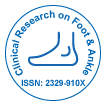Наша группа организует более 3000 глобальных конференций Ежегодные мероприятия в США, Европе и США. Азия при поддержке еще 1000 научных обществ и публикует более 700 Открытого доступа Журналы, в которых представлены более 50 000 выдающихся деятелей, авторитетных учёных, входящих в редколлегии.
Журналы открытого доступа набирают больше читателей и цитируемости
700 журналов и 15 000 000 читателей Каждый журнал получает более 25 000 читателей
Индексировано в
- Google Scholar
- Шерпа Ромео
- Открыть J-ворота
- Академические ключи
- РефСик
- Университет Хамдарда
- ЭБСКО, Аризона
- OCLC- WorldCat
- Публикации
- Женевский фонд медицинского образования и исследований
- Евро Паб
- ICMJE
Полезные ссылки
Журналы открытого доступа
Поделиться этой страницей
Абстрактный
The Influence of Walking Speed and Heel Height on Peak Plantar Pressure in the Forefoot of Healthy Adults: A Pilot Study
Rangra P, Santos D, Coda A, Jagadamma K
Background: The body of empirical research is suggestive of the fact that faster walking speed and increasing heel height can both give rise to elevated plantar pressures. However, there is little evidence of the interaction between walking speed and heel height on changes in plantar pressure. Therefore, the aim of this study was to investigate whether the effect of heel height on plantar pressure is the same for different walking speeds.
Methodology: Eighteen healthy adults, between the ages of 18 and 35 were assessed for changes in peak plantar pressure at walking speeds of 0.5 mph, 0.8 mph, 1.4 mph and 2.4 mph on a treadmill, wearing heels of 2 cm, 3 cm, 6 cm and 9 cm. Both the speed of walking and heels were randomly assigned to each participant. Peak plantar pressure values were determined in the forefoot region using the F-scan system which made use of in-shoe insoles. Data were analysed using two-way ANOVA.
Results: Increasing heel height and walking speed resulted in significantly higher peak plantar pressure in the forefoot. Post-hoc analysis also confirmed the findings of two-way ANOVA of significant increase in peak plantar pressure with increments in heel height and walking speed. The two-way ANOVA illustrated significantly higher peak plantar pressures in both the forefeet due to interaction of walking speed and increasing heel heights.
Conclusion: This study suggests that an interaction of walking speed and footwear design on distribution of plantar pressure exists. Therefore it is necessary to standardize walking speed and shoe design in future studies evaluating plantar pressures.
Журналы по темам
- Биохимия
- Ветеринары
- Генетика и молекулярная биология
- Геология и науки о Земле
- Еда и питание
- Иммунология и микробиология
- Инженерное дело
- Клинические науки
- Материаловедение
- медицинские науки
- Науки об окружающей среде
- Общая наука
- Сельское хозяйство и аквакультура
- Социальные и политические науки
- Уход и здравоохранение
- Фармацевтические науки
- Физика
- Химия

 English
English  Spanish
Spanish  Chinese
Chinese  German
German  French
French  Japanese
Japanese  Portuguese
Portuguese  Hindi
Hindi